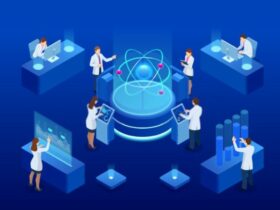Introduction Of Top Best AI Technologies You Must Know
Top Best AI Technologies You Must Know. Artificial intelligence (AI) is one of the biggest technological revolutions in recent years. It has the potential to change many aspects of our lives, from retail to healthcare. In this blog post, we will explore some of the top best AI technologies you must know if you want to take advantage of its potential.
From natural language processing and facial recognition to machine learning and robotics, read on to find out which AI technologies are positively impacting your life and business.
Machine Learning
Machine learning is the process of making intelligent decisions using data. It can be used in a variety of applications, such as predicting customer behaviour, managing supply chains, and automating decision-making.
There are several different machine learning algorithms available, and each has its strengths and weaknesses. Here are five of the best:
1. Ridge regression
Ridge regression is a popular machine learning algorithm that’s used to predict future events. It works by monitoring past events to identify patterns (aka “ridges”) that suggest future outcomes.
2. Support vector machine (SVM)
SVM is a type of machine learning algorithm used to determine which objects in a data set are similar or different. It uses mathematical formulas to find the optimal hyperplane configuration for separating the data into training and test sets. This configuration produces the best predictions for future events based on past data.
3. Bayesian statistics
Bayesian statistics is a branch of statistics that uses probabilistic models to make predictions about future events. It’s often used in conjunction with other machine learning algorithms, such as SVM, to improve accuracy and precision.
4. Random forests
Random forests are a type of machine learning algorithm that’s used to make predictions about future events by combining several different types of models. This approach helps improve accuracy and overall prediction accuracy by taking advantage of the diversity of data points within a given population
Deep Learning
Deep learning is a subset of machine learning that employs artificial neural networks, which are computer systems that can model complex mathematical relationships.
Deep learning has recently become one of the most important AI technologies because it enables machines to learn complex tasks without being explicitly programmed. This makes deep learning particularly suited for tasks such as facial recognition and natural language processing.
One of the biggest benefits of deep learning is that it can explore large data sets more effectively than other types of machine learning. This makes deep learning a powerful tool for predicting outcomes in complex environments.
Natural Language Processing
The field of artificial intelligence (AI) is rapidly evolving, with new capabilities and technologies being introduced at a rapid pace.
Here are five AI technologies that you must know:
1. Natural language processing (NLP): This technology is used to understand and interpret human speech. NLP can be used for a variety of tasks, such as sentiment analysis, customer service automation, and machine learning.
2. Machine learning: This technology is used to develop models that allow computers to learn from data without being explicitly programmed. Machine learning can be used for a variety of tasks, such as automatic captioning, fraud detection, and cancer detection.
3. Robotics: Robotics allows machines to operate autonomously in environments that they have been designed to work in. Robotics has been used in manufacturing, transportation, and healthcare settings.
4. Augmented reality (AR): AR uses virtual images or objects that are overlaid with real-world scenes to enhance user interaction. AR can be used for a variety of tasks, such as navigation and advertising placement.
5. deep learning: Deep learning is a type of machine learning that uses neural networks with many interconnected layers of processing nodes. These networks can “learn” complex patterns by training on large amounts of data sets
Speech Recognition
Now that we have covered the basics of AI and its potential, it is time to delve into some of the most commonly used AI technologies. Here are the five best AI technologies you must know if you want to make your artificial intelligence project a success:
1. Speech Recognition
This technology is essential for understanding human language, and it can be used in various applications such as customer service, digital assistants, Google Search and more. Implementing speech recognition into your AI project will allow machines to understand natural language commands and carry out tasks accordingly.
2. Natural Language Generation
Natural language generation is the process of creating text that accurately reflects the thoughts or sentiments of a user or system. This technology can be used for a variety of purposes such as customer support, online chatbots and more. By incorporating natural language generation into your AI project, you can create systems that can communicate with users in an intuitive manner.
3. Machine Learning
Machine learning is a branch of AI that enables machines to learn from data without being explicitly programmed. This technology can be used for a variety of purposes such as recognizing patterns in data, identifying fraudulent activities and more. By incorporating machine learning into your AI project, you can help machines become smarter over time by benefiting from their experience and knowledge.
4. Computer Vision
Computer vision is the process of understanding the content of images using computers. This technology can be used for a variety of purposes such as facial recognition
Knowledge Graphs
There are several AI technologies that you should be aware of if you want to stay up-to-date in the field. Here are the five best AI technologies:
1. Natural Language Processing (NLP)
NLP is a critical part of any AI system, as it allows machines to understand and respond to human speech. NLP tools can help identify the meaning of words, discern between different sentences, and parse complex sentences.
2. Machine Learning
Machine learning is a subset of AI that allows computers to learn on their own by observing data and making predictions based on that data. This technology is often used in conjunction with NLP, as it helps train the machine learning algorithm.
3. Computer Vision
Computer vision is one of the key components of AI, as it allows machines to understand and interpret images. This technology can be used for tasks such as recognizing objects, reading text, and detecting faces.
4. Robotics and Automation
Robots and automation allow machines to work independently or collaboratively to carry out specific tasks. Robotics can help automate processes or carry out specific tasks, while automation allows machines to operate without human supervision.
The use of these technologies has been increasing significantly over the past few years, as they have proven to be extremely effective in several fields, including manufacturing, logistics, retail sales, healthcare delivery and many more.
Predictive Analytics
Predictive analytics is a branch of machine learning that helps to make predictions about future events or behaviours from data. Predictive analytics can be used in a variety of settings, including marketing, business intelligence, customer service, and finance.
To use predictive analytics effectively, you need to have the right data set. The data must be accurate and contain enough information to make reliable predictions. Predictive analytics also requires good modelling skills. You need to create models that accurately reflect the data characteristics and how they relate to the outcome you are trying to predict. You Can Also Read Top Best Advancing Technologies In 2022.
In addition to data collection and modelling, predictive analytics also requires good computing resources. Your computer needs to be able to handle large amounts of data and fast processing speeds. It’s also important to have a robust infrastructure that can support real-time streaming of data and quick response times for crunching the numbers.
Predictive analytics can be used in many different ways in business settings. It can help you identify trends and patterns in your data so you can make better decisions about your overall business strategy. Predictive analytics also enables you to forecast future demand for your products or services. This allows you to plan for potential shortages or oversupply and take appropriate action sooner rather than later.
Recommendation Systems
Recommendation systems are a type of artificial intelligence that allows for the automatic identification and recommendation of products or services. These systems can be used in a variety of applications, such as online shopping and search engines.
The most common type of recommendation system is the collaborative filtering system. In this type of system, a group of users is divided into two or more subgroups, each of which is asked to make a recommendation about a product or service. The system then uses the recommendations made by the different groups to suggest new products or services to the individual user.
Another common type of recommendation system is the neural network model. In this type of system, a set of artificial neurons are assigned to represent different features of a product or service. The system then uses these neurons to learn how to make recommendations about those products or services.
Both types of systems have their advantages and disadvantages. The collaborative filtering system is generally faster than the neural network model, but it has less accuracy overall. The neural network model is more accurate, but it can take longer to get started
Speech Translation and Recognition
Speech Translation and Recognition
Technology has come a long way in the past few years. With the help of artificial intelligence, translations and recognition have become easier than ever. Here are some of the best AI technologies you must know:
1. Google Translate: This is probably one of the most popular AI technologies out there. It can translate between multiple languages quickly and accurately. You can also use it to scan documents or text for certain keywords and then have the translation appear right on the screen.
2. Apple Translate: While Google Translate is more widely used, Apple has its version that’s just as good if not better. It’s easy to use and can recognize common phrases and words across multiple languages.
3. Microsoft Translator: Another top option is Microsoft Translator which is especially handy for business purposes. It can handle multiple translations at once and has a wealth of features to make sure your translations are accurate and precise.
4. Neural Networks: Neural networks are another popular tool used for speech recognition and translation. They’re able to mimic how human brains work when decoding or translating language, which makes them very accurate in terms of recognizing patterns.
Conclusion
AI technologies are changing the way we live, work and play. Here are some of the most important AI technologies to know about: -Artificial Intelligence -Machine Learning -Matrix Factorization -Computer Vision

















Leave a Reply
View Comments